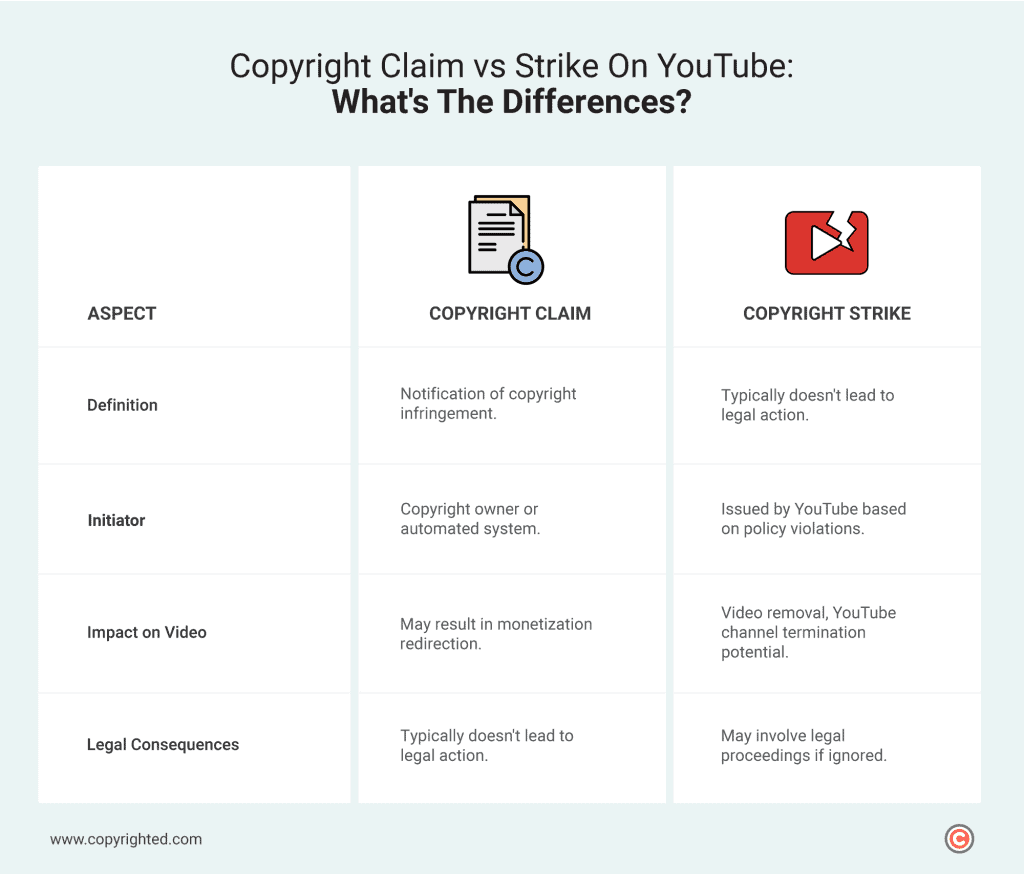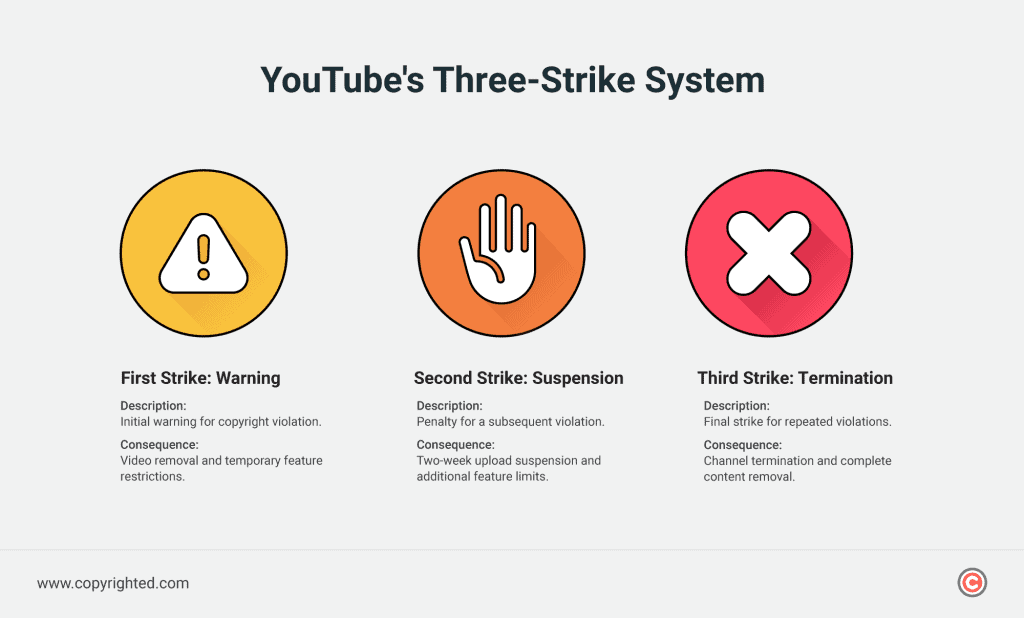Starting a YouTube channel can be an exciting journey, offering creativity and community engagement. However, amidst the excitement, it’s important to recognize the responsibilities and obligations that come with this platform.
Creators often underestimate the risks of copyright infringement, which can be dangerous if you’re not well-informed. So before starting your YouTube journey, be sure to educate yourself about copyright.
This article will focus on two essential concepts for YouTube creators: copyright claims and copyright strikes.
Understanding their differences, importance, and consequences is key to protecting your content, keeping a good reputation, and growing your channel. Let’s explore the details of copyright on YouTube and learn proactive steps to avoid potential challenges.
- A copyright claim is a formal notification informing a creator that someone else asserts ownership or rights to a portion of their content.
- A copyright strike is a formal penalty issued by YouTube for repeated violations of copyrighted material policies.
- YouTube’s copyright strike system operates on a three-step structure, each phase carrying increasing severity and consequences for content creators.
Table of Contents
Copyright Claim vs Strike on YouTube: What’s the Differences?
A copyright claim is a notification that your content incorporates copyrighted material, initiated either by the copyright holder or an automated system. While it may impact monetization, it typically doesn’t lead to immediate legal action.
On the other hand, a copyright strike is a more severe penalty issued by YouTube for policy violations, particularly if copyright infringement is repeated. Strikes can cause your video to be removed from YouTube, it can also result in demonetization, and, in extreme cases, channel termination, with potential legal consequences for non-compliance.
Below is a comparison table that offers a quick reference point on the difference between copyright and copyright claim, outlining the key distinctions between these two elements. Understanding these differences is important for a YouTube creator to uphold the platform’s policies and sustain a strong online presence.

Now that we’ve set the stage, let’s explore each term in more detail.
What is a Copyright Claim?
A copyright claim is a notification that a portion of your content contains copyrighted material owned by someone else. This can include various forms, ranging from snippets of music to clips from videos.
If you receive a copyright claim, don’t worry because a copyright claim does not automatically indicate any wrongdoing on your part. Instead, consider it as a constructive heads-up, signaling that the copyright holder has identified their protected content within yours.
It’s an opportunity to address the matter, understand the concerns, and take necessary actions to comply with copyright regulations. This proactive approach helps maintain a respectful and collaborative environment within the digital content creation sphere.
What is a Copyright Strike?
In contrast, a copyright strike is a more serious matter. A copyright strike is a formal penalty on platforms like YouTube for repeated violations of copyrighted material policies,
Think of it as a red flag, signaling a direct violation of YouTube’s policies related to copyrighted material. Unlike a copyright claim, which serves as a mere alert, a strike is a formal penalty.
Copyright strikes aren’t random, they happen when your content consistently breaks copyright rules. The more strikes you get, the more serious the consequences, putting your channel at risk and potentially threatening its future.
The results of a copyright strike range from removing specific videos to the most extreme measure — terminating your entire channel.
YouTube uses a three-strike system to manage copyright issues. This system aims to warn and give creators chances to fix problems before taking severe actions.
It’s important to steer clear of copyright strikes to protect the long-term reputation of your online presence.
How YouTube Issues Copyright Strikes?

Now that you’re familiar with the definitions of copyright claim and strike, let’s take a closer look at the mechanics behind how YouTube issues copyright strikes. To give you a clearer picture, here’s a quick rundown of the process:
- Automated Detection: YouTube employs sophisticated algorithms designed to identify copyrighted material within videos. This automated detection system scans content, flagging instances where copyrighted elements are found.
- Manual Reports: Copyright holders also have the option to manually report instances of infringement to YouTube. This involves the copyright owner directly notifying the platform about content that they believe violates their intellectual property rights.
- Three-Strike System: If your video violates copyright policies on three separate occasions, you become susceptible to receiving a copyright strike. This approach aims to provide content creators with opportunities to resolve their mistakes after initial warnings, emphasizing the importance of consistent compliance with copyright regulations.
The Consequences of a Copyright Claim and Strike
The outcomes of a copyright claim and copyright strike differ in severity.
A copyright claim serves as a warning, without immediate severe penalties. On the other hand, collecting multiple copyright strikes is more serious and can result in significant consequences.
Now, let’s explore the legal implications associated with each of these actions.
Consequences of a Copyright Claim
When a copyright claim is issued on your video, YouTube concurrently sends a notification to the copyright owner, referred to as a Content ID claim. This Content ID claim is part of YouTube’s system, automatically alerting copyright owners about the detected use of their copyrighted material.
Unlike a copyright claim that informs the content creator, a Content ID claim serves as a means for copyright owners to manage their content on the platform. It allows them to choose how they want to handle their copyrighted material within the identified video, whether through monetization, performance tracking, or, in certain instances, blocking.
But can a copyright claim become a strike? If a Copyright ID claim is proven valid, and you fail to take down the video in question, you can get a copyright strike.
The introduction of a Content ID claim does not entail immediate penalties for the content creator, but it influences how the copyrighted material is treated within the video on the platform.
Consequences of a Copyright Strike
YouTube’s copyright strike system operates on a three-step structure, each phase carrying increasing severity and consequences for content creators. This three-tiered approach is designed to address copyright violations systematically, providing a series of measures aimed at educating, warning, and, if necessary, taking significant actions against content that infringes upon copyright policies.
The first strike is a warning that informs content creators their content has violated copyright policies. YouTube may also require removing the specific video causing the strike.
This can lead to temporary restrictions on certain channel features, impacting capabilities like live streaming or posting content longer than 15 minutes. Additionally, the affected video may have its monetization capabilities restricted, meaning you may no longer earn revenue from ads on that particular video.
As the consequences escalate with the accumulation of a second strike, a two-week upload suspension is enforced.
During this period, content creators are unable to upload new content or stream. Simultaneously, additional channel features may face temporary restrictions and monetization is likely to be further restricted on the affected videos.
Getting a third copyright strike can lead to serious consequences, possibly resulting in the termination of the entire channel.
If this third strike occurs within 90 days of the initial strike, YouTube may terminate the channel. Such termination entails the removal of the entire content library and subscriber base and marks the end of the channel’s existence.
The seriousness of each strike highlights the need for content creators to stay proactive and prevent moving to the next level. As a content creator, it’s important to prioritize following copyright policies and swiftly address any issues that arise after receiving a strike.
How to Avoid a Copyright Claim and Strike on YouTube?
Now that you know about the challenges copyright claims and strikes can bring, let’s look at ways to protect your channel. Here are some practical ways to avoid copyright claims and copyright strikes:
- Use Licensed Material: Whenever you can, only use content you have the proper licenses or permissions for. This involves getting permission from the copyright owner or ensuring that your use falls within the scope of the licensed terms.
- Leverage Public Domain Content: Check out public domain or Creative Commons-licensed content. These resources are free to use without worrying about copyright issues, but make sure to follow the terms mentioned in the Creative Commons license.
- Employ Fair Use: Familiarize yourself with the principles of fair use and incorporate them into your content creation strategy. Fair use allows for the use of copyrighted material under specific circumstances such as commentary, criticism, or educational purposes.
- Create Original Content: Reduce the risk of unintentional copyright violations by creating original content. Creating unique and authentic material reduces the need for external copyrighted sources and decreases the likelihood of copyright problems.
- Use YouTube’s Copyright Tools: Learn how to use YouTube’s copyright tools. These tools can help you find possible copyright problems in your content before you publish it, allowing you to deal with issues beforehand.
- Stay Mindful of Music Licensing: Pay special attention to the music you use in your videos. Ensure that you have the necessary licenses for any music tracks you use to prevent copyright claims related to audio content.
Frequently Asked Questions
Can a copyright claim turn into a strike?
Yes, repeated claims on your YouTube channel for similar issues can escalate to a strike, especially if you don’t address the concerns.
What happens if you get a copyright claim?
Receiving a claim doesn’t have immediate consequences, but it may affect your video’s monetization and direct funds to the copyright holder.
What happens after you receive a copyright strike?
The first copyright strike doesn’t have severe consequences, but getting multiple strikes can lead to video removal, channel demonetization, and eventual termination.
Can you remove a copyright claim?
In most cases, you can’t remove a claim yourself. However, you can dispute the claim if you believe it’s false.
How long does a copyright strike last?
Copyright strikes expire after 90 days, but the strike itself remains on your channel. Accumulating three strikes within 90 days may lead to severe consequences.


